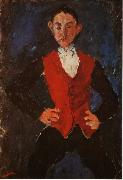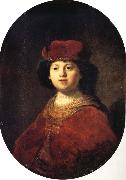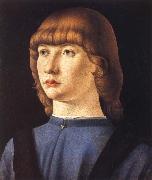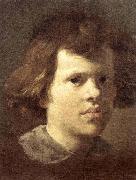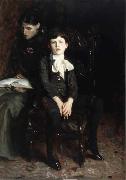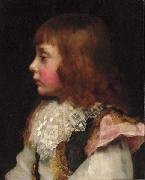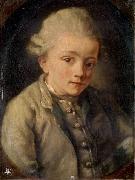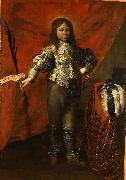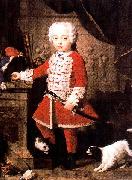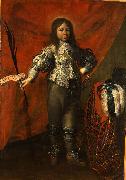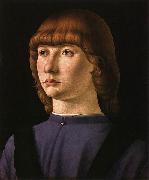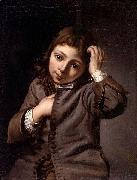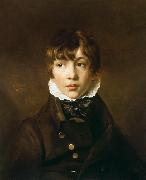Wholesale Oil Painting Reproductions No Minimum and Door to Door! |
|||||||||||
|
|
|||||||||||

|
|||||||||||
|
|
|
||||||||
All Chaim Soutine Oil Paintings |
||||||||
|
|
||||||||
|
|
||||||||
|
Artist Introduction: Chaim Soutine Art Locations
Lithuanian 1893-1943
Soutine was born in Smilavichy near Minsk, Belarus (then part of the Russian Empire). He was the tenth of eleven children.
From 1910?C1913 he studied in Vilnius at the Vilna Academy of Fine Arts. In 1913, with his friends Pinchus Kremegne and Michel Kikoine, he emigrated to Paris, where he studied at the Ecole des Beaux-Arts under Fernand Cormon. He soon developed a highly personal vision and painting technique.
For a time, he and his friends lived at La Ruche, a residence for struggling artists in Montparnasse, where he became friends with Amedeo Modigliani. Modigliani painted Soutine's portrait several times, most famously in 1917, on a door of an apartment belonging to Leopold Zborowski, who was their art dealer. Zoborowski supported Soutine through the World War I, taking the struggling artist with him to Nice to escape the German bombing of Paris.
In 1923, the American collector Albert C. Barnes visited his studio and immediately bought sixty of Soutine's paintings.
Soutine once horrified his neighbours by keeping an animal carcass in his studio so that he could paint it (Carcass of Beef). The stench drove them to send for the police, whom Soutine promptly lectured on the relative importance of art over hygiene. In February 2006 this painting sold for £7.8 million to an anonymous buyer in London.
Soutine produced the majority of his works from 1920 to 1929. He seldom showed his works, but he did take part in the exhibition of Independent Art held in 1937 in Paris, where he was at last hailed as a great painter. Soon thereafter France was invaded by German troops. As a Jew, Soutine had to escape from the French capital and hide in order to avoid arrest by the Gestapo. He moved from one place to another and was sometimes forced to seek shelter in forests, sleeping outdoors. Suffering from a stomach ulcer and bleeding badly, he left a safe hiding place for Paris in order to undergo emergency surgery, which failed to save his life. On August 9, 1943, Chaim Soutine died of a perforated ulcer. Soutine was interred in Cimeti??re du Montparnasse, Paris. |
||||||||
|
|
||||||||
|
Portrait of a Boy Painting ID:: 3786 |
1928
92.1 x 65.1cm
National Gallery of Art, Washington
|
|||||||
Height Width |
INS/CM Quality |
|||||||
|
X |
| |||||||
|
|
||||||||
All REMBRANDT Harmenszoon van Rijn Oil Paintings |
||||||||
|
|
||||||||
|
|
||||||||
|
Artist Introduction: Born 1606, Died 1669.One of the great Dutch painters and printmakers of the 17th century, Rembrandt van Rijn is best known for his expressive use of light and shadow (also called chiaroscuro) in his many portraits. Raised in Leiden, he studied with Pieter Lastman (1583-1633) in Amsterdam, then returned to Leiden around 1625 and set up shop as a teacher and portrait artist. Sometime between 1630 and 1632 Rembrandt relocated to Amsterdam, where he spent the rest of his career. Though he had his detractors (some of whom considered him coarse and "low born"), Rembrandt was successful and famous during his lifetime, though he fell on financial hard times in his later years. He was a master printer and produced hundreds of group portraits and historical paintings, including The Anatomy Lesson of Dr. Tulp (1632), The Military Company of Captain Frans Banning Cocq (1642) and Aristotle with a Bust of Homer (1653). His portraits -- including a lifelong trail of intriguing and rather frank self-portraits -- reveal his interest in psychological study and continue to be admired as landmarks in Western art. The Military Company of Captain Frans Banning Cocq is also known as "The Night Watch" because it was thought the painting depicted a nighttime scene. When the painting was cleaned in the 1940s it became obvious that it depicted a daytime scene... He married Saskia van Ulenburgh (also Uylenburgh) in 1634. |
||||||||
|
|
||||||||
|
|
Portrait of a Boy Painting ID:: 34596 |
mk93
oil on wood
67x47.5cm
|
||||||
Height Width |
INS/CM Quality |
|||||||
|
X |
| |||||||
|
|
||||||||
All Jacometto Oil Paintings |
||||||||
|
|
||||||||
|
|
||||||||
|
Artist Introduction: Italian Early Renaissance Painter, active 1472-1497 |
||||||||
|
|
||||||||
|
|
Portrait of a boy Painting ID:: 42922 |
mk170
1480-1485
Tempera and oil on wood
22.9x19.7cm
|
||||||
Height Width |
INS/CM Quality |
|||||||
|
X |
| |||||||
|
|
||||||||
All unknow artist Oil Paintings |
||||||||
|
|
||||||||
|
|
||||||||
|
Artist Introduction: |
||||||||
|
|
||||||||
|
|
Portrait of a Boy Painting ID:: 63839 |
1638 Oil on canvas Galleria Borghese, Rome The portrait of a youth with impressive features is an unusual interpretation of childhood. It belongs to the works in which the brushwork becomes increasingly spontaneous and seems to model the forms like a chisel sculpting marble.Artist:BERNINI, Gian Lorenzo Title: Portrait of a Boy Painted in 1601-1650 , Italian - - painting : portrait |
||||||
Height Width |
INS/CM Quality |
|||||||
|
X |
| |||||||
|
|
||||||||
All John Singer Sargent Oil Paintings |
||||||||
|
|
||||||||
|
|
||||||||
|
Artist Introduction: 1856-1925
John Singer Sargent Locations
John Singer Sargent (January 12, 1856 ?C April 14, 1925) was the most successful portrait painter of his era. During his career, he created roughly 900 oil paintings and more than 2,000 watercolors, as well as countless sketches and charcoal drawings. His oeuvre documents worldwide travel, from Venice to the Tyrol, Corfu, the Middle East, Montana, Maine, and Florida.
Before Sargent??s birth, his father FitzWilliam was an eye surgeon at the Wills Hospital in Philadelphia. After his older sister died at the age of two, his mother Mary (n??e Singer) suffered a mental collapse and the couple decided to go abroad to recover. They remained nomadic ex-patriates for the rest of their lives. Though based in Paris, Sargent??s parents moved regularly with the seasons to the sea and the mountain resorts in France, Germany, Italy, and Switzerland. While she was pregnant, they stopped in Florence, Italy because of a cholera epidemic, and there Sargent was born in 1856. A year later, his sister Mary was born. After her birth FitzWilliam reluctantly resigned his post in Philadelphia and accepted his wife??s entreaties to remain abroad. They lived modestly on a small inheritance and savings, living an isolated life with their children and generally avoiding society and other Americans except for friends in the art world. Four more children were born abroad of whom two lived past childhood.
Though his father was a patient teacher of basic subjects, young Sargent was a rambunctious child, more interested in outdoor activities than his studies. As his father wrote home, ??He is quite a close observer of animated nature.?? Contrary to his father, his mother was quite convinced that traveling around Europe, visiting museums and churches, would give young Sargent a satisfactory education. Several attempts to give him formal schooling failed, owning mostly to their itinerant life. She was a fine amateur artist and his father was a skilled medical illustrator. Early on, she gave him sketchbooks and encouraged drawing excursions. Young Sargent worked with care on his drawings, and he enthusiastically copied images from the Illustrated London News of ships and made detailed sketches of landscapes. FitzWilliam had hoped that his son??s interest in ships and the sea might lead him toward a naval career.
At thirteen, his mother reported that John ??sketches quite nicely, & has a remarkably quick and correct eye. If we could afford to give him really good lessons, he would soon be quite a little artist.?? At age thirteen, he received some watercolor lessons from Carl Welsch, a German landscape painter. Though his education was far from complete, Sargent grew up to be a highly literate and cosmopolitan young man, accomplished in art, music, and literature. He was fluent in French, Italian, and German. At seventeen, Sargent was described as ??willful, curious, determined and strong?? (after his mother) yet shy, generous, and modest (after his father). He was well-acquainted with many of the great masters from first hand observation, as he wrote in 1874, ??I have learned in Venice to admire Tintoretto immensely and to consider him perhaps second only to Michael Angelo and Titian.?? |
||||||||
|
|
||||||||
|
|
Portrait of a Boy Painting ID:: 69638 |
oil on canvas painting by John Singer Sargent |
||||||
Height Width |
INS/CM Quality |
|||||||
|
X |
| |||||||
|
|
||||||||
All Valentine Cameron Prinsep Prints Oil Paintings |
||||||||
|
|
||||||||
|
|
||||||||
|
Artist Introduction: Indian-born British Pre-Raphaelite Painter, 1838-1904
Henry Prinsep was an intimate friend of G. F. Watts, under whom his son first studied. Val Prinsep also worked in Paris in the atelier Gleyre; and 'Taffy' in his friend George du Maurier's novel Trilby, is said to have been sketched from him. He was an intimate friend of John Everett Millais and of Burne-Jones, with whom he travelled in Italy. He had a share with Rossetti and others in the decoration of the hall of the Oxford Union.
Prinsep first exhibited at the Royal Academy in 1862 with his Bianca Capella, his first picture, which attracted marked notice, being a portrait (1866) of General Gordon in Chinese costume. Princep lent the costume to Millais who used it in his own painting Esther.
The best of his later exhibits were A Versailles, The Emperor Theophilus chooses his Wife, The Broken Idol and The Goose Girl. He was elected A.R.A. in 1879 and R.A. in 1894. In 1877 he went to India and painted a huge picture of the Delhi Durbar, exhibited in 1880, and afterwards hung at Buckingham Palace. |
||||||||
|
|
||||||||
|
|
Portrait of a boy Painting ID:: 73049 |
"Portrait of a boy, quarter-length, in a brown waistcoat and white lace collar," oil on canvas, by the British artist Valentine Cameron Prinsep. 18 in. x 14 in. (45.7cm. x 35.6 cm.) Courtesy of Christie's.
cjr |
||||||
Height Width |
INS/CM Quality |
|||||||
|
X |
| |||||||
|
|
||||||||
All Jean-Baptiste Greuze Oil Paintings |
||||||||
|
|
||||||||
|
|
||||||||
|
Artist Introduction: French Rococo Era Painter, 1725-1805
French painter and draughtsman. He was named an associate member of the Academie Royale de Peinture et de Sculpture, Paris, in 1755 on the strength of a group of paintings that included genre scenes, portraits and studies of expressive heads (tetes d'expression). These remained the essential subjects of his art for the next 50 years, except for a brief, concentrated and unsuccessful experiment with history painting in the late 1760s, which was to affect his later genre painting deeply. Though his art has often been compared with that of Jean-Simeon Chardin in particular and interpreted within the context of NEO-CLASSICISM in general, it stands so strikingly apart from the currents of its time that Greuze's accomplishments are best described, as they often were by the artist's contemporaries, as unique. He was greatly admired by connoisseurs, critics and the general public throughout most of his life. His pictures were in the collections of such noted connoisseurs as Ange-Laurent de La Live de Jully, Claude-Henri Watelet and Etienne-Franeois, Duc de Choiseul. For a long period he was in particular favour with the critic Denis Diderot, who wrote about him in the Salon reviews that he published in Melchior Grimm's privately circulated Correspondance litt?raire. His reputation declined towards the end of his life and through the early part of the 19th century, to be revived after 1850, when 18th-century painting returned to favour, by such critics as Theophile Thore, Arsene Houssaye and, most notably, Edmond and Jules de Goncourt in their book L'Art du dix-huitieme siecle. By the end of the century Greuze's work, especially his many variations on the Head of a Girl, fetched record prices, and his Broken Pitcher (Paris, Louvre) was one of the most popular paintings in the Louvre. |
||||||||
|
|
||||||||
|
|
Portrait of a Boy Painting ID:: 78052 |
18th century
Oil on canvas
34 x 45 cm (13.4 x 17.7 in)
cjr |
||||||
Height Width |
INS/CM Quality |
|||||||
|
X |
| |||||||
|
|
||||||||
All Carlo Ceresa Oil Paintings |
||||||||
|
|
||||||||
|
|
||||||||
|
Artist Introduction: Carlo Ceresa (January 20, 1609 - January 29, 1679) was an Italian painter of the Baroque period active mainly around Bergamo.
His early life and training are poorly recorded. He likely trained in Bergamo. He visited Venice, yet esconced himself in the small town of San Giovanni Bianco in Val Bembrana. Mostly recalled for his portraiture, Ceresa also painted altarpieces and religious works in an understated fashion. |
||||||||
|
|
||||||||
|
|
Portrait of a boy Painting ID:: 80682 |
Date 17th century
Medium Oil
CJR |
||||||
Height Width |
INS/CM Quality |
|||||||
|
X |
| |||||||
|
|
||||||||
All Pierre Subleyras Oil Paintings |
||||||||
|
|
||||||||
|
|
||||||||
|
Artist Introduction: 1699-1749
French painter, draughtsman and printmaker, active in Italy. He was one of the foremost French painters of portraits and religious compositions of the first half of the 18th century. From 1728 he lived in Rome, first as a student and then as an independent master working principally for the religious orders. |
||||||||
|
|
||||||||
|
|
Portrait of a boy Painting ID:: 83500 |
18th century
Medium Oil
cyf |
||||||
Height Width |
INS/CM Quality |
|||||||
|
X |
| |||||||
|
|
||||||||
All Carlo Ceresa Oil Paintings |
||||||||
|
|
||||||||
|
|
||||||||
|
Artist Introduction: Carlo Ceresa (January 20, 1609 - January 29, 1679) was an Italian painter of the Baroque period active mainly around Bergamo.
His early life and training are poorly recorded. He likely trained in Bergamo. He visited Venice, yet esconced himself in the small town of San Giovanni Bianco in Val Bembrana. Mostly recalled for his portraiture, Ceresa also painted altarpieces and religious works in an understated fashion. |
||||||||
|
|
||||||||
|
|
Portrait of a boy Painting ID:: 83505 |
17th century
Medium Oil
cyf |
||||||
Height Width |
INS/CM Quality |
|||||||
|
X |
| |||||||
|
|
||||||||
All Jacometto Veneziano Oil Paintings |
||||||||
|
|
||||||||
|
|
||||||||
|
Artist Introduction: Italy (Venezia 1472 -1497 ) - Painter |
||||||||
|
|
||||||||
|
|
Portrait of a boy Painting ID:: 90978 |
between 1475(1475) and 1480(1480)
Medium tempera and oil on panel
cyf |
||||||
Height Width |
INS/CM Quality |
|||||||
|
X |
| |||||||
|
|
||||||||
All Michiel Sweerts Oil Paintings |
||||||||
|
|
||||||||
|
|
||||||||
|
Artist Introduction: (29 September 1618-1664), also known as Michael Sweerts, was a Flemish painter of the Baroque period, active in Rome (1645-1656) in the style of the Bamboccianti. The Bamboccianti were known for depicting genre scenes of daily life, but Sweerts's contributions to this genre display greater stylistic mastery and social-philosophical sensitivity than many of his colleagues in this "school." Highly successful in Rome during his years there, Sweerts's reputation suffered a severe collapse not long after his death, lasting centuries; but thanks especially to the 2002 international monographic exhibition devoted entirely to him, Michael Sweerts: 1618-1664, he has begun once again to enjoy the esteem his work clearly merits.
Born in Brussels, he arrived in Rome in 1646, and rapidly moved into the circle of Flemish painters associated with Pieter van Laer (leader of the so-called Bamboccianti painters) and that resided near Santa Maria del Popolo. In 1647, he attended meetings of the Accademia di San Luca, although not as a member. Despite the fragmentary nature of evidence pertaining to his career in Rome and the post-mortem eclipse of his reputation, we know that Sweerts succeeded in creating for himself a sufficiently exalted reputation in the city so as to enter into the service of the ruling papal family itself, the Pamphilj, more specifically, Camillo Pamphilj, nephew of reigning Pope Innocent X who, at the encouragement of Camillo, bestowed upon Sweerts the papal title of Cavaliere di Cristo, the same honor enjoyed by the likes of Gian Lorenzo Bernini and Francesco Borromini. Despite working in the highest echelons of papal patronage in Rome, sometime between 1652 and 1654, for reasons unknown Sweerts left the Eternal City and returned to the North, and by 1656, he had returned to Brussels, where he joined the painter's guild. He joined the Paris Foreign Missions Society as a lay brother and became a devout Christian. In 1658 he made the guild a self portrait as a farewell gift and moved to Amsterdam, where he would oversee the building of a ship for travel with the aforementioned Missions Étrangeres to Palestine. |
||||||||
|
|
||||||||
|
|
Portrait of a boy Painting ID:: 90986 |
1658(1658)
Medium Oil on panel transferred to canvas
Dimensions Height: 29 cm (11.4 in). Width: 22 cm (8.7 in).
cyf |
||||||
Height Width |
INS/CM Quality |
|||||||
|
X |
| |||||||
|
|
||||||||
All George Hayter Oil Paintings |
||||||||
|
|
||||||||
|
|
||||||||
|
Artist Introduction: 1792 - 1871
English painter and printmaker. He was the son of Charles Hayter (1761-1835), miniature painter, author of manuals for art instruction and Professor of Perspective and Drawing to Princess Charlotte. In 1808 George entered the Royal Academy Schools, and in 1815 was appointed Painter of Miniatures and Portraits by Princess Charlotte. Hayter was awarded the British Institution's premium for history painting for the Prophet Ezra (1815; Downton Castle, Heref. & Worcs), purchased by Richard Payne Knight. Encouraged by his patron, John Russell, 6th Duke of Bedford, he travelled to Italy to study in 1816, gaining election as an honorary member of the Accademia di S Luca in Florence. Returning to London in 1818, Hayter practised as a portrait painter in oils and history painter and occasionally acted as an art dealer. Dubbed 'The Phoenix' by William Beckford, Hayter showed a pomposity that irritated his fellow artists, but he mixed freely with many aristocratic families. |
||||||||
|
|
||||||||
|
|
Portrait of a boy Painting ID:: 94575 |
1820(1820)
cjr |
||||||
Height Width |
INS/CM Quality |
|||||||
|
X |
| |||||||
|
|
||||||||
|
Prev Next
|
||||||||
|
|
||||||||
|
Related Paintings to George Hayter :. |
||||||||
|
|
||||||||
|
CONTACT US |
